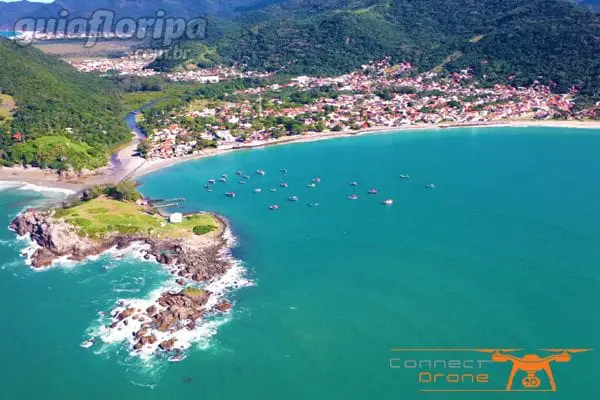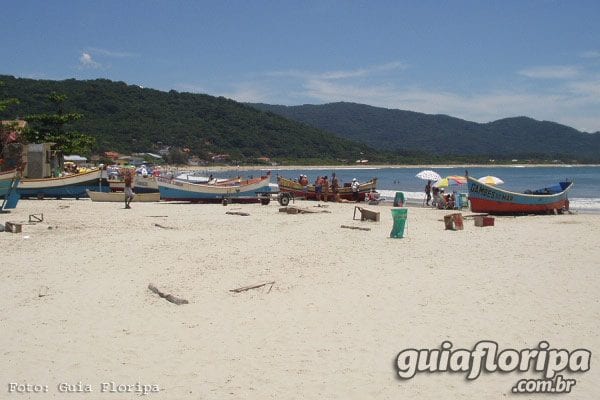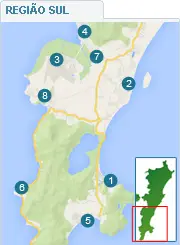Armação do Pântano do Sul - Florianópolis neighborhood
Região: south of the island
Close quarters: Campeche (8,5 km) | south swamp (4,3 km)
Nearby beaches: Armacao Beach | Matadeiro Beach (south)| Lagoa do Peri beach (west)| Morro das Pedras beach (north)
Distances: Centro e Bus Station 22 km | Airport 13 km
Also find: boat trips, water sports, surf, fishery, river, trail, "foot-in-the-sand" restaurants

The neighborhood South Swamp Frame is located in the south of Santa Catarina Island, facing the eastern portion of the island, facing the Atlantic Ocean, approximately 22 km away from the downtown florianopolis.
With 2.837 inhabitants, Armação, as it is better known by locals, is a small neighborhood that retains the characteristics of an old fishing village.
The main access roads to the neighborhood are Rodovia SC-406, in the north-south direction, and Avenida Antônio Borges do Santos.
The latter ends at the edge of the River Sangradouro, which originates from the dark waters of the Peri Lagoon and has its mouth at the junction of the beaches of Frame and butcher.

Along Avenida Antônio Borges do Santos, mainly in the square in front of the church, called the center of Armação, there are some restaurants and shops, mostly intended for the sale of beach items. Markets, bakeries and pharmacies are scattered along Highway SC-406.
Nightlife options in the region are scarce, except for a few bars that open during the summer season and close again between March and November.
ADVERTISING
History
The name Armação comes from a not very noble chapter in the history of the region, although indispensable for the economic development of the entire island.
The Frames were the places intended for the processing of whale blubber for the production of oils and sludge, used in public lighting, as a lubricant in gears and as a binding element in mortars (gala-gala), used in constructions at the time. Other parts of the animal were also used, such as spermaceti, a white, oily and viscous matter extracted from its brain, and ambergris, a solid substance, from the animal's intestines. Both had several uses, being used in the preparation of detergent, consolidator, emollient, ointments, ointments, balms, cosmetics and finer soaps. In addition to these, fins and even meat were still used in the slaves' diet.

The region of Armação do Pântano do Sul was occupied, about 5000 years before, by primitive peoples, who left marks of their presence through lithic workshops. The occupation by the colonists began in 1772, with the installation of the "Armação e Fazenda de Santa Anna da Lagoinha" for the exploration of whaling (whaling). The term "Lagoinha" referred to the Peri Lagoon, which had its surroundings used for the agricultural production that supported Armação.
In this period, the first inhabitants of this region were the Portuguese and the black slaves. The Portuguese and their descendants, were salaried, and worked as responsible for the administration of the Armação, as "Masters" on the ships and as merchants. Black slaves were assigned heavy work, such as manual services in construction, maintenance of facilities and farming, and cleaning and conservation of whales, when captured.
ADVERTISING
The Azoreans and Madeirans, who had been sent by the Portuguese crown to settle the island of Santa Catarina, were hired as whalers and had variable remuneration according to their position on the boat, as harpooners and rowers, but only during the hunting season, which lasted between three to four months a year.

The development of the small village was guided by the chapel of Sant'Anna, built in the same year as the arrival of the Portuguese and blacks. The first facilities were built near the chapel and, over time, the other buildings were distributed around it.
As one of the main objectives of the foundation of Armação do Pântano do Sul was to encourage predatory whaling, this was, for a long time, the main economic activity of the community. However, this was not the only activity developed, the villagers also fished other marine species and had in the cultivation of the land an important source for their subsistence.

In the XNUMXth century, the importance of the frames spread along the coast of Santa Catarina was so great for the local economy that they became part of the Intendency of the Navy of Santa Catarina. But it wasn't just that fact that changed Armação's dynamics; with the encouragement of Italian and German immigration, some German families were sheltered in the small village to the south of Santa Catarina Island.

Whale fishing was quite expressive until the 1920s, when it began to decline due to the installation of traps in the Falkland Islands and, later, due to the decrease in appearances of the species on the coast of Santa Catarina. However, several of the existing structures in Santa Catarina extended their activities until the 1950s, among them the Armação do Pântano do Sul.
Between the 1960s and 1970s, Florianópolis underwent major urban development and began to receive more tourists. As access to regions further away from the city center became easier, many were able to discover the natural charms of Armação do Pântano do Sul and many others moved definitively to the neighborhood. As a result, the location grew significantly in the 1980s and 1990s.
ADVERTISING
Whales and the Whaling Boats
Right whales are cetaceans, belonging to the genus Eubalaena. The most sighted species in southern Brazil is the southern right whale (Eubalaena australis), one of three species of right whale. Surrounded by a 40 centimeter layer of fat, this species measures about 18 meters and can weigh up to 60 tons.
They were called "Franca" for their tame behavior, which facilitated the action of hunters. The tactic developed by them to capture them was simple: to attract the mother whale, they attached their calf to the boat. In an attempt to protect the baby whale, the mother got too close to the boat and ended up being hit by the harpoon that was thrown by a limb, standing, at the tip of the boat. After attracting and killing the mother, the calf was also killed and its body discarded, as it did not contain a large amount of fat.
A whaleboat was crewed by six oarsmen, a helmsman and a harpooner. The boats varied in size, between 10 to 12 meters in length and 2,20 meters in width (beam). They had the same bow (front) and stern (bottom), to facilitate maneuvers in both directions, a mast, yard, rudder, six benches and seven oars - a reserve oar. The candles were square or round, made of denim or cotton.
Video of Armação Beach
DISCOVER MORE Neighborhoods in the South Region of Florianópolis

See neighborhoods in other regions of Florianópolis:
Hiper Select Supermarket - Novo Campeche
Hyper Select supermarket | Supermarket at Novo Campeche in Florianópolis.











